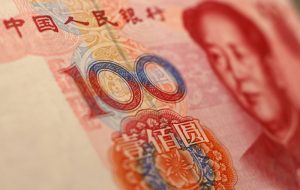Exclusive-Chinese exporters using currency swaps to retain dollars as yuan sags By Reuters
© Reuters. FILE PHOTO: U.S. Dollar and Chinese Yuan banknotes are seen in this illustration taken January 30, 2023. REUTERS/Dado Ruvic/Illustration/File Photo SHANGHAI/SINGAPORE (Reuters) – Chinese exporters are using a complicated currency swap strategy to avoid converting their dollar earnings into yuan for fear of losing out on potential gains in the U.S. currency, official

© Reuters. FILE PHOTO: U.S. Dollar and Chinese Yuan banknotes are seen in this illustration taken January 30, 2023. REUTERS/Dado Ruvic/Illustration/File Photo
SHANGHAI/SINGAPORE (Reuters) – Chinese exporters are using a complicated currency swap strategy to avoid converting their dollar earnings into yuan for fear of losing out on potential gains in the U.S. currency, official data and conversations with companies show.
China’s state banks are counterparties to some of these swap transactions that allow exporters to exchange their dollars for yuan, suggesting the country’s currency regulator is comfortable with these trades even as authorities try to curb intense pressure on the yuan in spot markets.
Exporters such as Ding, a Shanghai-based businessman, are holding on tightly to their dollar earnings, reluctant to sell and convert them into yuan, which recently skidded to nine-month lows.
“My fellow exporter friends and I have been discussing if we want to use foreign exchange swap trades to get the yuan,” said Ding, who trades in electronics and toys and prefers to go by his last name.
“The key concern is that the price of the dollar keeps going up.”
The yuan has lost more than 5% against the U.S. dollar so far this year, including a 2% drop this month alone, and is being dragged even lower by foreign capital flowing out of the weakening economy.
The swaps allow exporters to place their dollars with banks and get yuan instead, but through a contract that will eventually reverse the flows and give them back their dollars.
However, while they remove a much-needed source of dollar supplies into spot yuan markets, analysts reckon Chinese monetary authorities can’t really force exporters to convert dollars.
Chinese companies swapped a record $31.5 billion for yuan with commercial banks in the onshore forwards market in July alone, and a total of $157 billion so far this year, according to the country’s currency regulator.
Ding had initially planned to convert his dollar holdings when the yuan weakened past 7-per-dollar, a level the local currency has crossed only three times since the 2008 Global Financial Crisis.
But he changed his mind as expectations grew that the Federal Reserve will drive the U.S. interest rates higher for longer, and for persistent weakness in the yuan whose yields are falling as China eases monetary policy to support sputtering economic activity.
“The growing monetary policy divergence is the key reason behind the trend,” said Gary Ng, senior economist for Asia Pacific at Natixis.
“As it is unlikely to see any fundamental change in the short run, the gravity of yield differentials will drag the yuan and prompt exporters to bet on the dollar.”
HOW THE SWAP WORKS
Rising U.S. yields and their widening gap with Chinese rates have also flipped rates in the currency forwards market, such that exporters have no incentive to even lock in a forward rate to sell their dollars. One-year yuan is quoted at 7.02 per dollar, versus a spot rate of 7.29.
Traders say the State Administration of Foreign Exchange permits sell-buy dollar-yuan swaps, if companies use their own funds.
When exporters swap higher-yielding dollars for the cheaper yuan for even 3 months, they get local currency for business needs and also earn a pick-up of an annualised 3.5% on the swap deal.
“By trading FX swaps, exporters can postpone their settlements while meeting their yuan demand,” said Becky Liu, head of China macro strategy at Standard Chartered (OTC:) Bank.
A less remunerative but equally effective option is for them to place the dollars as deposits at 2.8%, and use that as collateral for yuan loans, with net gains of around 2%.
China’s lenders have lowered those dollar deposit rates twice this year to discourage hoarding and spur exporters to convert their dollars into yuan, yet more of them seem to have turned instead to swaps.
The partially state-owned China Merchants Bank even nudges exporters to use swaps.
“If companies want to retain their dollar deposits, they can sign up foreign exchange swap products to increase the returns on dollar deposits,” the bank said in trade recommendations.
China’s central bank has meanwhile ramped up efforts to defend the yuan, by continuing its months-long trend of setting firmer-than-expected yuan mid-point benchmarks and even asking some domestic banks to scale back their outward investments.
Exporters’ swaps, meanwhile, give state banks a pile of dollars to use in their yuan operations, in which they can undertake swaps to acquire the dollars from the onshore forwards market and sell them in the spot market to stem fast yuan declines.
 آموزش مجازی مدیریت عالی حرفه ای کسب و کار Post DBA آموزش مجازی مدیریت عالی حرفه ای کسب و کار Post DBA+ مدرک معتبر قابل ترجمه رسمی با مهر دادگستری و وزارت امور خارجه |  آموزش مجازی مدیریت عالی و حرفه ای کسب و کار DBA آموزش مجازی مدیریت عالی و حرفه ای کسب و کار DBA+ مدرک معتبر قابل ترجمه رسمی با مهر دادگستری و وزارت امور خارجه |  آموزش مجازی مدیریت کسب و کار MBA آموزش مجازی مدیریت کسب و کار MBA+ مدرک معتبر قابل ترجمه رسمی با مهر دادگستری و وزارت امور خارجه |
 مدیریت حرفه ای کافی شاپ |  حقوقدان خبره |  سرآشپز حرفه ای |
 آموزش مجازی تعمیرات موبایل آموزش مجازی تعمیرات موبایل |  آموزش مجازی ICDL مهارت های رایانه کار درجه یک و دو |  آموزش مجازی کارشناس معاملات املاک_ مشاور املاک آموزش مجازی کارشناس معاملات املاک_ مشاور املاک |
برچسب ها :Currency ، Dollars ، ExclusiveChinese ، exporters ، retain ، Reuters ، sags ، swaps ، yuan
- نظرات ارسال شده توسط شما، پس از تایید توسط مدیران سایت منتشر خواهد شد.
- نظراتی که حاوی تهمت یا افترا باشد منتشر نخواهد شد.
- نظراتی که به غیر از زبان فارسی یا غیر مرتبط با خبر باشد منتشر نخواهد شد.





ارسال نظر شما
مجموع نظرات : 0 در انتظار بررسی : 0 انتشار یافته : ۰